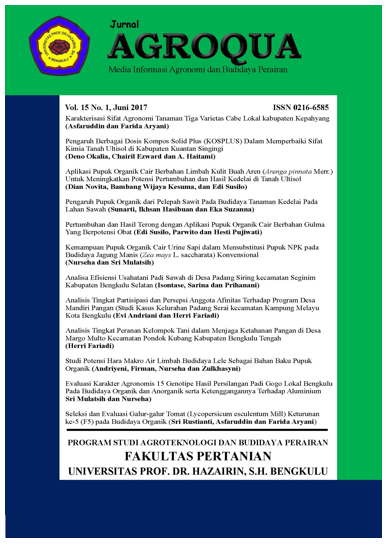ADOPSI PEMANFAATAN TANAMAN REFUGIA SEBAGAI PENGENDALIAN HAMA TERPADU PADA PETANI CABAI DI KECAMATAN CILAWU KABUPATEN GARUT
DOI:
https://doi.org/10.32663/ja.v19i2.2042Keywords:
adoption, chili, integrated pest controls, refugiaAbstract
Pests attack at Cilawu Subdistrict had increases cases, pests attack because of climate change. The adoption of integrated pest control technology in Cilawu District is relatively low, so a strategy is needed to increase the level of application of horticultural commodity technology. This study analyze the level of farmer adoption of refugia plant as Integrated Pest Controls (IPM), identified factors caused an strategies adoption of refugia plant use at chili farmer. This study held on April till June 2021 used intstrument questionnaire to collect all data and analize used descriptive an reggresion. The research data consisted of primary data with data collection plus interviews with chili farmers, and secondary data from local institutions. The primary data analysis method used descriptive and regression analysis. The study involved 61 people as research respondents who were members of farmer groups. The adoption of integrated pest control technology in Cilawu District is low so there is a need for a strategy to increase the level of application of horticultural crop commodity technology. The adoption level of technology at Cilawu Subdistrict are low level and need improvement to raise the tecnology horticultural cultivation. Pests controls use the refugia plant push the balances of ecosystem an decrease the pests attact. The result of the analysis showed adoption of technology are high. Factors affect the adoption are number of family and the information services. Strategies to improve level of adoption based on analaysis to increase the adoption are information strenghtening by exstension, discussion an by model demo plot.
Downloads
Published
Issue
Section
License
Authors who publish with this journal agree to the following terms:
- Authors grant the journal right of first publication with the work simultaneously licensed under a Creative Commons Attribution 4.0 Internasional (CC BY 4.0) Licence that allows others to use and share the work with an acknowledgment of the work's authorship and initial publication in this journal.
- The author(s) still hold the copyright of his/her/their work and retain publishing rights without restrictions such as (but not limited to) patent right, lecture, book and reproduce the article for own purposes.
















